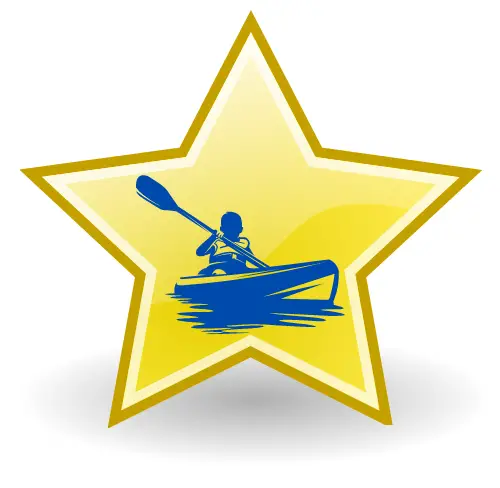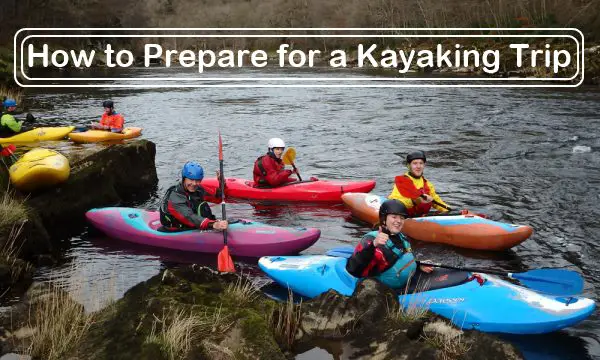How to plan a camping trip, where and when to stay, and how to set it up? It is worth answering these questions already at the stage of rafting trip planning. What is different for us will be a shortstop during a one-day trip. What is different is a bivouac with accommodation on the route of a few day’s expeditions.
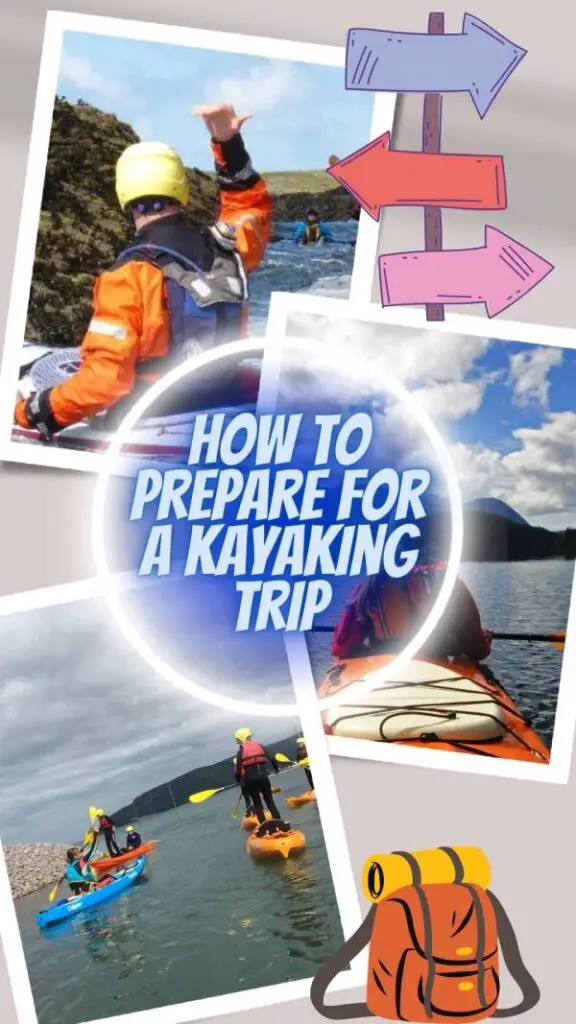
It is worth appointing a leading person in a group. He or she will ask about recommended stopping places and will explain all matters interesting to the group. We will try to discuss some of these issues in the text below. From our side, we always recommend asking the person renting kayaks about the details. Such a person knows the best (or at least should) conditions on the route we will paddle.
Table of Contents
Equipment
Mandatory:
- life jacket;
- sleeping bag and mat;
- gloves with rubber nubbins for paddling and camp work;
- airtight bags for clothing and other belongings;
- mug, spoon, bowl, knife;
- hygienic items;
- first-aid kit;
- large trash bags.
Preferably:
- tent
- swamp boots
- long rain gear
- Windbreaker or jacket, rain jacket, pants or jeans, socks, underwear.
- Thermal underwear or sweatshirt
- Sneakers or sneakers, sandals
- Bandanas, caps, or hats (weather permitting)
- Light-colored, long-sleeved shirt, shorts below the knee
- Swimsuit or bathing suit
What place to choose for camping?
Even on a one-day, several-hour trip, it is worth stopping, stretching your bones, playing ball, or eating something. Communes and state forests provide their areas adjacent to the river places equipped with benches, and trash cans. Sometimes they also provide shelters and a place for a bonfire. In private rooms, even those suggesting a stopping place, you should ask about the possibility of using the facility.
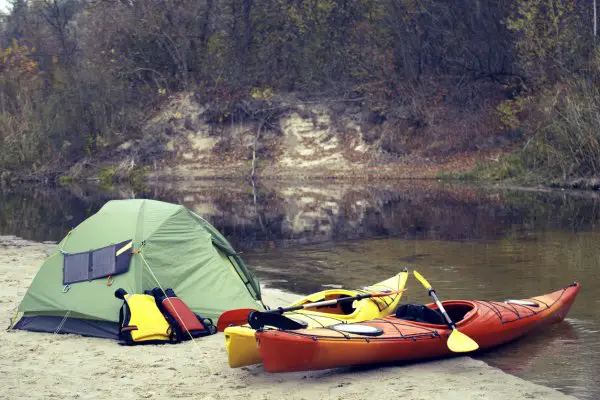
If kayaking lasts a few days, we choose mostly places adjusted to accommodation needs. For some of us, it will be a meadow uncontaminated by civilization and a range of WiFi waves. For others, it will be a facility providing access to drinking water, shelter under a roof, and hot water under a shower. These will come in handy during a longer kayaking trip. Do not enter the areas of reserves, areas protected by fences, or pastures belonging to private farmers. It may turn out, that despite the already set up camp we will be asked out of it. In such a case it would be good to politely “get along” together.
How do I set up at a rest stop?
During a kayaking rally, it is always worth taking care of discipline in a group, and order at the place of stopping. Oars and capes we leave in our kayaks because scattered here and there can “change the owner”. At the camping place, we can find other groups, with whom we will have to share the whole camping infrastructure. Let’s think then, to organize our equipment. We put the kayak in one place, turning them on the side (possible rain will not flood our cockpits).
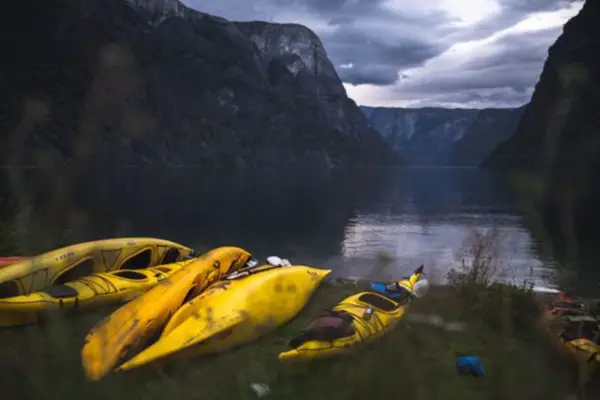
Paddles and lifebelts should be taken closer to the tents. During the day, we hang the capes to dry. Oars should be placed in such a way as not to walk on them. Remember, that kayaking equipment is to be used only on water. Do not sit on the kayaks (elastic material gets deformed). Do not pitch tents on roads or uphill entrances (the interior will be flooded in case of rain). We put our equipment inside and look for a place for a campfire. On well-equipped camping sites such a place is usually already designated. In places without infrastructure, you will have to take care of several important factors.
Where can you make a fire?
At campgrounds managed by a host/owner, we don’t have to worry about it. Such a place is already defined and well-prepared. On forest glades without such blessings, we have to do it ourselves. We pick and put down the litter, and occupy and surround it with stones. We do not light fires on peat bogs and near cereal fields, always at a safe distance from tents and clusters of trees (conventionally 100m).
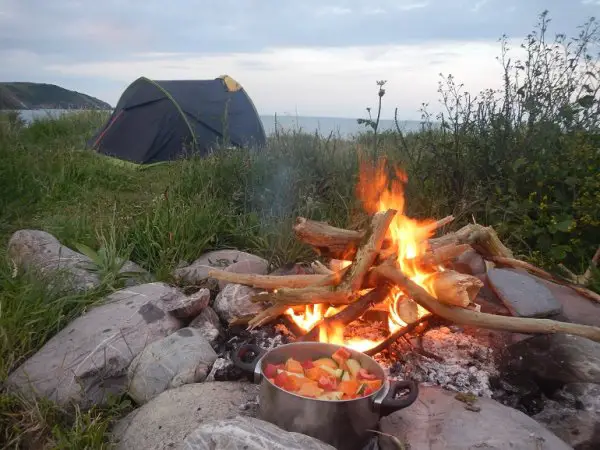
Chop wood with caution and watch out for people around you. It is necessary to have a vessel with water nearby to extinguish the fire at the end. Unburned wood should be spread out and water should be poured over it again, or sand should be covered over it. During periods of drought, the use of open fire is prohibited. We can only use a gas stove very carefully to prepare a meal and not leave it unattended. Let’s not light too big bonfires – they are only to warm us up and create a nice atmosphere. On a campsite, we are fellow campers, not competitors.
How to behave on a camping trip?
Let’s take care to observe good-neighborly, fire, and sanitary rules. At campgrounds, we are usually not alone. Respect the presence of other people, lowering the tone in the late evening hours. Do not disturb them with swearing or drunken behavior. A good waterman’s custom is to invite frozen fellow campers to the campfire and at night, not to disturb their desire to rest.
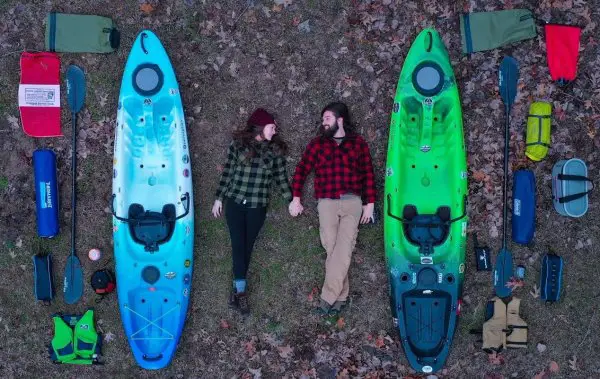
We always maintain order around our camp and clean up trash. Some facilities even have specially designated areas for waste separation. In undeveloped areas, we bury organic garbage such as tea grounds, stumps, and vegetable peelings. We take other trash to the canoe and leave it in the nearest designated place.
How do you prepare your body for kayaking?
Preparing your body for kayaking is essential to ensure an enjoyable and safe experience. Here’s a detailed approach:
Physical Conditioning: Develop upper body strength by focusing on your arms, shoulders, and back muscles. Incorporate exercises like push-ups, pull-ups, and rows into your fitness routine.
Core Strength: A strong core helps with stability and paddling efficiency. Include exercises like planks, Russian twists, and leg raises.
Cardiovascular Fitness: Kayaking can be physically demanding. Improve your stamina through activities like running, swimming, or cycling.
Flexibility: Stretch regularly to maintain flexibility in your upper body and legs. This helps prevent muscle strain and aids in effective paddling.
Proper Posture: Practice good posture to prevent back pain while kayaking. Strengthen your lower back and practice sitting with a straight back.
Hydration and Nutrition: Stay well-hydrated and eat a balanced meal before kayaking to maintain energy levels.
Safety Training: Learn basic kayaking safety and rescue techniques, including how to re-enter your kayak if you capsize.
Gear and Clothing: Wear suitable clothing for weather conditions and a life jacket at all times for safety.
Warm-Up: Do a quick warm-up before getting into the kayak to prevent injuries.
Stay Informed: Be aware of weather conditions, water currents, and potential hazards in your kayaking location.
By following these steps, you’ll be physically and mentally prepared for kayaking, enhancing your overall experience on the water while minimizing the risk of injury.
How do I prepare for my first time kayaking?
Preparing for your first kayaking adventure is crucial to ensure a safe and enjoyable experience. Here’s a detailed guide:
Choose a Suitable Location: Select a calm and beginner-friendly water body such as a lake or slow-moving river for your first kayaking trip.
Wear Appropriate Clothing: Dress in moisture-wicking, quick-dry clothing and water shoes. Don’t forget a wide-brimmed hat and sunglasses for sun protection.
Life Jacket: Always wear a properly fitting personal flotation device (PFD) or life jacket.
Learn Basic Paddling Techniques: Familiarize yourself with basic strokes like forward, backward, and turning strokes. You can find tutorials online or take a lesson.
Safety Gear: Pack essential safety gear such as a whistle, first aid kit, and a dry bag for your belongings.
Weather Check: Check the weather forecast and plan your trip on a calm day with favorable conditions.
Float Plan: Share your float plan with someone, including your expected return time and location.
Stay Hydrated and Sunscreen: Bring water to stay hydrated and apply sunscreen for sun protection.
Stay Calm and Relaxed: Once on the water, remain calm, and paddle at your comfort level. Don’t be afraid to take breaks.
Respect Nature: Respect the environment and wildlife, and leave no trace.
Learn Self-Rescue: Practice re-entering your kayak in shallow water in case you capsize.
Guided Tours: If unsure, consider joining a guided tour with experienced instructors.
By following these steps, you’ll be well-prepared for your first kayaking adventure, ensuring a safe, enjoyable, and memorable experience on the water.
What are the three golden rules of kayaking?
The three golden rules of kayaking are essential for safety and a successful kayaking experience:
Wear a Personal Flotation Device (PFD): Always wear a properly fitting PFD, also known as a life jacket, while kayaking. It provides buoyancy and can be a lifesaver in case of an accident or capsize.
Learn and Practice Proper Paddling Techniques: Master basic paddling strokes to control your kayak effectively. Techniques like forward stroke, sweep stroke, and bracing are crucial for stability and maneuverability.
Respect Water Conditions and Environment: Be aware of weather, water conditions, and the environment. Check the weather forecast, understand tides and currents, and respect local regulations. Leave no trace, and respect wildlife and other water users.
Following these golden rules ensures your safety and the safety of others while enjoying your kayaking adventures.
What are four mistakes in kayaking?
There are several common mistakes that kayakers, especially beginners, should avoid to ensure a safe and enjoyable experience on the water. Here are four key mistakes in kayaking:
Inadequate Safety Precautions: Neglecting safety measures like not wearing a PFD (personal flotation device), not carrying essential safety gear, or not having a proper float plan can lead to dangerous situations. Always prioritize safety.
Overestimating Skills: Some kayakers attempt advanced conditions or challenging routes without the necessary skills and experience. Overestimating your abilities can lead to accidents, capsizes, or getting stranded.
Ignoring Environmental Impact: Disregarding environmental ethics by littering, disturbing wildlife, or not following Leave No Trace principles harms the environment and can lead to legal consequences. Respect nature and minimize your impact.
Lack of Proper Gear and Clothing: Inadequate clothing or equipment can lead to discomfort and even hypothermia in cold conditions. Always dress appropriately and carry essential gear, including a PFD, paddle leash, and dry bags for your belongings.
Avoiding these mistakes and continuously improving your kayaking knowledge and skills will contribute to a safer and more enjoyable kayaking experience.
What is the 50 90 rule kayaking?
The “50/90 Rule” in kayaking, also known as the “50/90 Principle,” is a general guideline that suggests that water temperatures below 50°F (10°C) and air temperatures below 90°F (32°C) should be treated with caution. This principle is particularly relevant for kayakers and other water enthusiasts.
Here’s what it means:
Water Temperature Below 50°F (10°C): When the water temperature falls below 50°F, it’s considered cold water. Cold water can be dangerous because it can lead to hypothermia if you’re exposed to it for an extended period. In such conditions, it’s crucial to wear appropriate gear like a wetsuit or drysuit and always have a personal flotation device (PFD) on.
Air Temperature Below 90°F (32°C): When the air temperature is below 90°F, it indicates that you might be dealing with cooler or even cold conditions, depending on the season and location. While not as critical as water temperature, it’s a reminder to dress warmly, stay dry, and be prepared for potential weather changes.
The 50/90 Rule emphasizes the importance of safety and preparedness when kayaking in varying conditions, particularly when the water is cold. It’s a reminder to prioritize personal safety by wearing appropriate gear, staying informed about weather conditions, and respecting the potential risks associated with cold water and less-than-ideal air temperatures.
What is the 120 rule for kayaking?
The 120 Rule for kayaking is a guideline used to estimate the duration of a kayaking trip. It states that for every 120 minutes spent on the water, you should allow yourself 20 minutes to rest and 30 minutes to set up camp or explore. This ensures that you don’t exhaust yourself before reaching your destination.
This rule is designed to ensure safety during long trips by preventing fatigue and exhaustion. It also provides enough time for breaks throughout your journey, allowing you to enjoy the scenery around you while paddling.
In addition to the rest and exploration time, the 120 Rule also advises against venturing more than 120 minutes away from land while kayaking. This means that any time spent out on the water should be limited to two hours at most, with plenty of time left over for returning back safely to dry land before sunset or other dangerous weather conditions set in.
Furthermore, it’s advised that you don’t paddle alone but rather have another experienced paddler come along as part of a team and remain within sight of each other at all times during your journey together.
What is the cold water rule for kayaking?
The “Cold Water Rule” is an important safety guideline for kayaking and other water activities. It emphasizes the need for special precautions and equipment when dealing with cold water, which is typically defined as water below 60°F (15.5°C). Here are the key aspects of the Cold Water Rule:
Wear a Personal Flotation Device (PFD): When kayaking in cold water, always wear a PFD. Cold water can impair your physical abilities quickly, so a PFD is essential for buoyancy and safety.
Dress for Immersion: Choose appropriate cold water paddling gear, such as a wetsuit or drysuit, neoprene gloves, and a neoprene hood. These items help retain body heat in cold water.
Stay Close to Shore: Avoid venturing too far from the shore or safety points when kayaking in cold water. This proximity allows for a quicker return in case of emergency.
Paddle with a Buddy: It’s safer to paddle with a partner in cold water. They can assist in case of capsizing, provide warmth, and help with rescues.
Know Self-Rescue Techniques: Learn and practice self-rescue techniques such as re-entering your kayak after a capsize. This knowledge can be crucial in cold water situations.
Use a Spray Skirt: A spray skirt can help keep water out of the kayak, keeping you drier and warmer.
Stay Informed and Prepared: Check weather conditions and water temperatures before kayaking in cold water. Carry essential safety equipment like a whistle, signaling devices, and a first aid kit.
The Cold Water Rule stresses the importance of being extra cautious and prepared when kayaking in cold water, as hypothermia can set in quickly, making it a potentially life-threatening situation. Always prioritize safety when engaging in cold water paddling.
What is a good distance to kayak?
The distance you can kayak depends on your skill level, physical fitness, and the type of kayak trip you’re planning. Here are some general guidelines to help you determine a suitable distance for kayaking:
Beginner Kayakers: If you’re new to kayaking, it’s best to start with shorter trips, typically ranging from 1 to 5 miles. This allows you to get accustomed to the kayak, paddling techniques, and build your stamina.
Recreational Kayaking: For recreational kayaking, where you’re primarily kayaking for enjoyment, distances of 5 to 10 miles can be a good range. These trips offer a nice balance of exercise and relaxation.
Day Trips: Day trips, often undertaken by more experienced kayakers, can range from 10 to 20 miles or more. These trips can be a great way to explore new areas and enjoy a full day on the water.
Overnight or Multi-Day Trips: For longer expeditions or camping trips, distances can vary significantly. Kayakers might cover 20 to 30 miles per day on multi-day journeys.
Fitness and Skill Level: Your personal fitness and skill level also play a crucial role. Experienced and physically fit kayakers can comfortably cover longer distances.
Conditions: The type of water you’re paddling on, including calm lakes, rivers, or coastal waters, can also influence the distance. Challenging conditions, strong currents, or rough seas may limit the distance you can comfortably kayak.
Remember that safety is a top priority when determining kayaking distances. Always consider factors like weather conditions, water temperature, equipment, and your ability to handle emergencies. It’s important to start with shorter distances, gain experience, and gradually work your way up to longer trips as your confidence and skills grow.
Am I too fat to kayak?
Whether or not you are too heavy to kayak depends on several factors, including your weight, the type of kayak, and your comfort level. Kayak weight limits vary based on the kayak’s design, so it’s essential to choose a kayak that can safely accommodate your weight.
If you’re concerned about whether you’re within the weight limit for a specific kayak, you can check the manufacturer’s guidelines or consult the kayak’s documentation. It’s essential to respect these weight limits to ensure your safety and the kayak’s stability. Exceeding weight limits can affect your ability to control the kayak and even pose a safety risk.
It’s also a good idea to seek advice from experienced paddlers or take lessons to learn how to kayak safely and comfortably. Remember that kayaking can be enjoyed by people of various body types, and with the right equipment and guidance, you can have a fantastic experience on the water.
What is the weight limit for kayaking?
The weight limit for kayaking can vary depending on the type and design of the kayak. Generally, recreational kayaks have weight limits ranging from 250 to 350 pounds (113 to 159 kilograms). However, sea kayaks and touring kayaks may have higher weight limits, often between 350 to 450 pounds (159 to 204 kilograms) due to their larger size and capacity for longer trips.
It’s crucial to check the manufacturer’s specifications and guidelines for the specific kayak you plan to use, as weight limits can differ. Exceeding the recommended weight limit can affect the kayak’s stability and safety, so it’s important to choose a kayak that suits your weight and the type of paddling you intend to do.
How do you sit in a recreational kayak?
Sitting properly in a recreational kayak is important for comfort, stability, and safety. Here are the steps to sit in a recreational kayak:
Approach the Kayak: Position your kayak near the water’s edge or launch area, making sure it’s stable and won’t tip over.
Straddle the Kayak: Stand on one side of the kayak, straddling it with your legs on either side of the cockpit.
Lower Yourself Gently: Slowly and carefully lower yourself into the kayak seat, aiming to sit in the middle of the cockpit. Avoid plopping down, as this can destabilize the kayak.
Place Your Feet: Extend your legs forward, resting your feet on the footrests or footpegs inside the kayak. Ensure your knees are bent and have some room to move.
Adjust the Backrest: If your kayak has an adjustable backrest, set it to a comfortable position that provides lumbar support.
Grip the Paddle: Hold the kayak paddle with both hands, one hand on the shaft and the other on the paddle’s grip. Keep the paddle in front of you.
Stabilize Yourself: Make sure your weight is evenly distributed, and you’re sitting upright. Engage your core muscles for balance.
Buckle Up: If your kayak has a seatbelt or straps, fasten them to secure yourself in the seat.
Check Your Comfort: Ensure you’re comfortable and have a clear range of motion for paddling.
Remember that the specific design of your recreational kayak and your body size may influence the exact way you sit. Always follow the manufacturer’s guidelines and practice getting in and out of the kayak before venturing out on the water to ensure you’re comfortable and safe.
How strenuous is kayaking?
Kayaking can be a physically demanding activity, similar to other outdoor sports. It requires you to move your body in a specific way and maintain a certain level of fitness. The intensity of the activity can vary based on several factors, such as the distance you’re paddling, the speed at which you’re moving, and the type of terrain you’re navigating through.
Paddling on flat water in calm conditions is less strenuous than paddling against strong currents or wind, or navigating through rough water. Similarly, a short paddle at a slow pace is less demanding than a long paddle at a fast pace.
In addition to the physical effort of paddling, kayaking also requires mental effort. You need to keep track of your location, monitor the water conditions, and navigate through various terrains. This can be mentally draining, especially during long trips or challenging conditions.
The level of strenuousness for kayaking can also vary among individuals. Factors such as fitness level, age, and physical condition can influence how strenuous kayaking is for you. For example, younger, fitter individuals may find kayaking less demanding than older, less fit individuals.
Lastly, safety is a priority when kayaking. This includes ensuring you’re in good physical condition to handle any emergencies that may arise during your trip. If you’re unsure about your fitness level or the suitability of kayaking for you, it’s a good idea to consult with a healthcare professional or a fitness expert sportsmedicine.
Our best posts:
